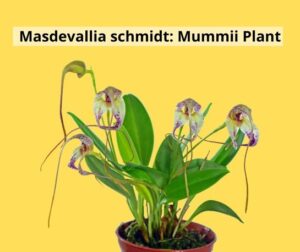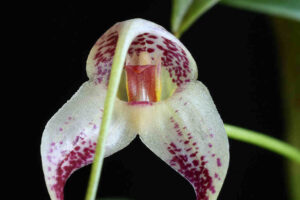Mummii Plant
Masdevallia Schmidt-Mummii is an orchid plant in the genus Masdevallia which falls under the family Orchidaceae. The genus Masdevallia consists of 500-600 species. This species has been first described in 1978 by two botanists viz., Carlyle August Luer and Rodrigo Escobar. It was first of all reported from the forest of Colombia at an elevation of 1800-2600m. This is the miniature sized cold loving epiphytic species with slender, erect stem (ramacauls).

They are distributed from Southern Mexico to Southern Brazil. Colombia, Venezuela, Ecuador, Peru and Bolivia are considered as the main centres of distribution. This plant is epiphytic in nature and found commonly in tropical rainforest. It is commonly found in high altitude especially in the environment where mist, rain, fog and relative humidity of 80-90% prevails.
Botanical Classification
| Kingdom | Plantae |
| Division | Magnoliophyta |
| Class | Liliopsida |
| Order | Asparagales |
| Family | Orchidaceae |
| Genus | Masdevallia |
| Species | schmidt |
Morphology of plant
The morphology of Mummii plant is described below:
Leaf
This plant has dull green leaves with a rough surface and has a pale longitudinal stripe in the middle. This pale longitudinal stripe has increased the aesthetic value of the Masdevallia Schmidt plant.
Flower

This plant usually flowers in the fall. Flowers are long cylinders and zygomorphic. The inflorescence arising from low in the ramacaul that measures 8-11cm usually bears a single flower. Flowers are solitary that are nestled amongst leaves. Its flowers are meretricious measuring 4-6 cm in length. Petals are pinkish-purple in colour.
Also Read:
Philodendron Pedatum(Variegated): Care And Propagation
Philodendron Deja Vu: Care & Propagation
Multilayer Farming: Is It The Future Of Sustainable Farming?
Care and Management
Growing Mummii Plant – Masdevallia Schmidt is too easy. However, you should take care of following factors:
Light
Bright but indirect light is preferred by this plant. About 25% shading in winter and 70-90% shading is required in winter. For better flowering, plentiful light is essential. In inadequate light conditions yellowing of leaves may occur that hinders the growth and development of plants. Also, too bright light conditions are also dreadful.
Temperature
Mummii is a cool loving epiphytic species. The favourable range of temperature for this species ranges between 10-20 degree celsius. Leaves may drop if the temperature above 30 oc prevails for a longer duration of time.
Yellowing of leaves may be observed at temperatures above 25 oc.
Soil
The soil mixture containing perlite, vermiculite and other chunky material is considered best for this plant. Generally light and loose soil is preferred.
Water
This is the moist loving plant and could not withstand dry conditions. However, too much wet conditions must be avoided. During summer daily watering is required whereas in spring and winter watering at weekly intervals is sufficient.
Plentiful availability of water should be ensured otherwise the plant will wilt or die.
Humidity
Since Orchid requires high humidity. So, humidity should be maintained around 70-80% for optimum growth and development.
Fertiliser
Orchids are not heavy feeders. So, fertilising them once every two week is sufficient. This is susceptible to salt. So avoid excess fertiliser. Always use balanced fertiliser to ensure proper growth and development.
Potting and Repotting
Potting is an important cultural practice for growing this plant. A pot of appropriate size should be selected. Potting mixture can be prepared by using one part of Sphagnum peat moss, One part of perlite and two parts of pine bark. Sphagnum Peat moss plays an important role in moisture retention and aeration. Perlite increases the air circulation around the root and also facilitates drainage. Pine bark also provides aeration, nutrients and also facilitates drainage.
Repotting should be done every two years. However, you can repot your Mummii plant when it starts to grow outside the containers and its roots emerge from the drainage hole. Generally, spring is considered the best season for repotting.
For repotting at first the plant is gently removed from the initial pot with a root ball and dead roots are trimmed off. A new pot of required size is selected and a potting mixture is placed in it and then the plant is transplanted in it.
Propagation
Orchid including mummii can be propagated easily by any of the following means:
i) Seed
Mostly orchid is propagated by asexual means. However, it is also propagated by seed. Seed propagation takes longer time as compared to other asexual means of propagation.
ii) Stem Cutting
After flowering, stems measuring about 1 foot length are snipped from the mother plant. There must be three to four nodes in each cutting. Then the cuttings are kept in a rooting tray containing a layer of pebbles, Sphagnum moss or bark. The tray is covered with plastic to maintain the humidity and temperature is maintained at around 75 -85 degree fahrenheit.
iii) By division
By division genetically similar plants are produced. In this method, the growing plant is simply divided into two or more parts each containing at least one new shoot. Splitting also encourages the plant to produce new shoots of better quality.
iv) Back Bulb
It is the method of producing new plants from matured flowered or unflowered back pseudobulbs. Plants propagated from this means usually require 2 to 3 or even more to reach flowering size.
Is It rare?
The genus Masdevallia consists of more than 300 species. The plant Masdevallia schmidt commonly occurs in high humid areas of the mountainous region.
Where to get this Plant?
Since Masdevallia is a cool loving plant and so this plant is usually found at higher elevations at an elevation of 1800-2600m. They are mostly found in high humid areas.
Conclusion
Mummii is an exotic plant that usually thrives in cool climates. This plant prefers bright but indirect sunlight and requires high humidity. Daily watering is required but too much wet condition is not suitable for this plant. This plant can be easily propagated by seed, bulb or stem cutting.
